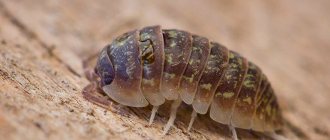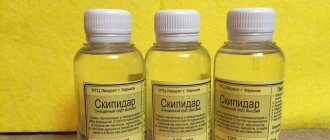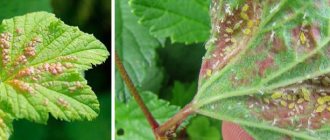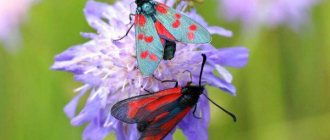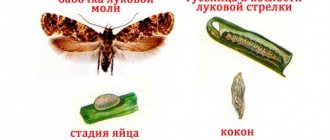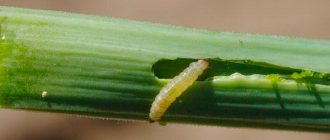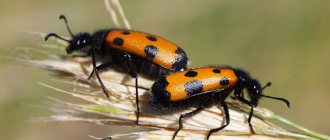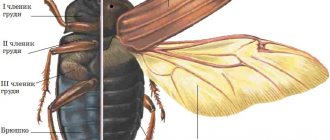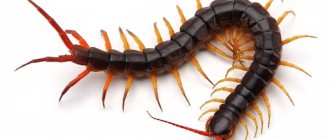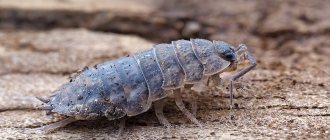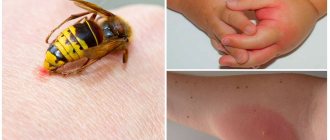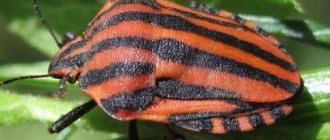There are more than 50 thousand species around the world, and the habitat is huge, in fact, everywhere where there is plant food. Most often, beetles are phytophages; in smaller numbers, they are phytosaprophages and saprophages, processing plant particles found in the soil.
An important feature of leaf beetles is that they do not feed on mushrooms, lycophytes, ferns and lichens. Their taste preferences remain with deciduous and coniferous trees, which are parasitized by 5 types of pests.
What they look like
Insects are small beetles whose body size is 3-5 mm.
Adult leaf beetles can have an ovoid, cylindrical or round body shape. Its length is 1.5-2 times its width. Insects are red, yellow or black, with or without a pattern on the body. It is always bright in color, sometimes it can acquire a metallic sheen.
The head with bulging eyes and antennae is retracted into the pronotum. The elytra can be free or fused. The wings are well developed. Some types of leaf beetles look like ladybugs. When insects sit on plants, they hide their short legs underneath them. The hind jumping legs of insects have an elongated shape.
Types of beetles
Strawberry leaf beetle
The beetle is yellow-brown in color. It grows to 3–4 mm in length. Gray larvae are 2–3 mm larger than adult insects. They appear on strawberry and strawberry beds during budding and damage plants throughout the summer.
Onion leaf beetle
Onion leaf beetle or onion rattle beetle
The beetle is 6–7.5 mm in size, red-orange in color, with a thick body and a large head. The larvae have a soft white body and a black head. Damages vegetable and ornamental crops.
Alder leaf beetle
The insect is 7 mm long and dark blue with a metallic sheen. The larvae look like a caterpillar, their body is black with a blue-green tint.
Viburnum leaf beetle
A beetle with an oval body 5–6 mm long, brown-yellow in color. The body is covered with dense short hairs.
The larvae are yellow-green with brown hairs on the upper side of the body and brown tubercles. The head and legs are darker than the rest of the parts. Older larvae reach 9–11 mm in length.
Elm leaf beetle
Elm leaf beetle
It lives in the steppe and forest-steppe zone in the European part of the country, in southern Siberia. The insect has an oblong yellow-brown body 5–8 mm long. Damages elm plants of all ages.
Poplar leaf beetle
A beetle 10–12 mm long with a black-blue body and bright red elytra. The larva has a thick gray-white or light green body with black dots on top, and a black head and legs.
Food and habitats
The food source of most species of pest beetles is the foliage of trees and shrubs.
Some types of leaf beetles eat other dead insects and fallen leaves. Adults eat holes in the leaves and lay their larvae on them, which, as they grow, eat them down to the veins. In this case, the plant stems remain untouched.
There are species of beetles that lay their larvae in the soil and even under water. The larvae developing in the soil actively eat up the roots of plants. Inflorescences are extremely rarely attacked by leaf beetles. The larvae deposited on the surface of the foliage are covered, for the purpose of protection, with a layer of excrement.
Lifestyle
From the name it is clear that these beetles live by eating leaves. The larvae can live directly on leaf blades, on the roots of plants in the ground, on stems, and sometimes under water.
Leaf beetles for the most part eat leaves of food plants. Some of them can feed on certain plants, others on any type of vegetation. There are species that prefer fallen leaves and animal carcasses.
By scraping the surface of the leaf blade, the larva or adult beetle makes a hole in it. However, such damage does not always indicate that it was caused by leaf beetles. Such holes can be left by sawfly larvae, caterpillars, snails, slugs, weevils and grasshoppers.
With intensive reproduction of leaf beetles, their number grows very quickly. They occupy most of the leaves on trees, shrubs and garden plants. As a result, if the necessary measures are not taken, all leaves may be destroyed. Sometimes plants suffer due to damage to the roots by the larvae of some leaf beetles. However, they do not cause significant harm to strong and strong specimens.
Leaf beetles include both pests of cultivated plants and trees, as well as beneficial insects that help control weeds. Pests cause significant damage to cabbage, strawberries, eggplants, potatoes, peppers, tomatoes, beets, tobacco, cereal plants, radishes, rapeseed, horseradish, onions, and garlic.
In addition, leaf beetles damage the leaves of alder, poplar, birch, willow and alder. However, along with this, there are species that destroy St. John's wort, ragweed, nightshade and other weeds.
Harm and benefit
Conventionally, beetles can be divided into 2 large groups:
- pests of trees and shrubs;
- beneficial insects that eat weeds.
Pest beetles can eat not only the foliage of fruit trees and berry bushes, but also agricultural plants such as strawberries, cabbage, eggplants, peppers, potatoes, beets, asparagus, etc. Weed eaters destroy ragweed, nightshade, St. John's wort, rapeseed and wild cruciferous vegetables. plants.
Beneficial beetle species include the ambrosia striped leaf beetle. This type of insect, along with St. John's wort eaters, was brought to Russia from Canada and the USA.
Poplar and blue willow leaf beetles cause great damage to ornamental plants. Some insect species are protected. These insects include the Uriankhai leaf beetles, which are listed in the Red Book.
Rodents
Mice cause great damage to vegetable crops: field voles (Apodemis agrarius), house voles (Mus musculus), common voles (Microtus arvalis), arable voles (M. agrestis), rats (Rattus). Rodents partially eat vegetative plants and damage heads of late-ripening cabbage varieties right in the beds. Damaged plants rot, are unfit for consumption, and cannot be stored.
Control measures: if there is a large number of rodents in late autumn (November), when the soil freezes, the hedgehogs go to sleep, lay out baits with rodenticides: rat death No. 1, warat, kilrat, norat, GryzNet-agro.
Control measures
Leaf beetles that have settled in a garden plot quickly multiply their population, creating a real threat to the harvest of fruits and other agricultural crops. The fight against it should include a set of measures. This is the only way to rid your garden of pest beetles.
Agrotechnical measures
This type of pest control measures includes strict adherence to planting technology, soil treatment with special preparations, as well as mechanical assembly and destruction of insects.
An important element of agrotechnical measures is the autumn digging of plants and digging up garden beds. During these activities, leaf beetles that have settled in the ground for wintering are destroyed.
In the spring, the soil dug up in the fall must be loosened. At the end of May and beginning of June, the rows are loosened and the fruit trees in the garden are re-dug. Pest beetles that appear on the foliage of plants are manually collected into boxes or bottles with an adhesive substance and burned along with trimmed branches of plants that have been affected by the leaf beetle. Vegetables in the garden beds infected with pests must be destroyed along with them.
Biological measures
In the fight against leaf beetles, preparations based on chemical compounds synthesized by living organisms are widely used.
The most famous remedy from this series is “Bitoxibacillin”. The bacterial insecticide has an intestinal effect. The basis of the drug is Bacillus thuringiensis var. This is a type of gram-positive bacteria. They secrete endotoxins that suppress larvae and adults. The disadvantage of the drug is its ability to effectively destroy only the first instar larvae. Treatment of plants affected by the leaf beetle should be started with this remedy immediately after the larvae appear on the plant foliage.
An equally popular biological preparation for combating leaf beetles among gardeners is Fitoverm. The basis of this product is Aversectin S.
This is a biological insecticide consisting of 4;
- B1a;
- A1a;
- A2a;
- B2a.
They are waste products of the fungi Streptomyces avermectilis. “Fitoverim” is widely used in the fight against adult insects. It has a contact-intestinal effect. The drug has a paralytic effect. Insects affected by it cannot move and die 7-10 days after treating the plants.
Chemical measures
What method of combating leaf beetles do you choose?
FolkChemical
Measures to combat leaf beetles of this species involve the use of synthetic chemicals.
All of them are combined into groups:
- Pyrethroids . The products are synthetic analogues of natural pyrethrins. They are found in large quantities in Dalmatian chamomile flowers. The drugs have a rapid enteric-contact effect. They do not lose their effectiveness during precipitation.
- Organophosphorus compounds . Poisonous substances with paralytic effects. Quickly and effectively destroy leaf beetles at all stages of their development. The disadvantage of the drugs is their danger to pets and birds.
- Neonicotinoids . The drugs are nerve poisons. The products are resistant to washing off by rain, have an immediate effect on insects and are moderately toxic to vertebrates. Neonicotinoids should not be used near apiaries. They are destructive to bees.
Prevention measures
To prevent the mass reproduction of leaf beetles in your garden or dacha, you need to follow simple preventive measures. They are not able to eliminate the likelihood of pests, but significantly reduce their number in the next season.
Effective measures:
- deep autumn digging of the site followed by spring harrowing;
- burning of plant residues after harvesting;
- regular loosening of the soil and removal of weeds throughout the entire period of crop development;
- pre-sowing watering of the beds with Aktara solution.
The best professional products for pest control
The drugs are highly effective. Their significant disadvantage is their weak effect on eggs laid by insects. Therefore, plants are treated against leaf beetles at least 2 times. Repeated treatment is carried out after 14-20 days. Sometimes even this amount of plant treatment is not enough to completely destroy the beetles. Insects can fly in from neighboring areas and they also need to be destroyed.
All professional preparations differ in the strength of their effect on insects.
"Karate"
The insecticide is considered one of the most effective means in the fight against leaf beetles. Can be used to exterminate the Colorado potato beetle, gall mites and other insect pests.
The product is available in the form of a concentrated emulsion. The consumption of “Karate” for preparing the solution is 1-5 ml per 10 liters of water. This amount of solution is enough to treat an area of up to 100 sq.m. A solution prepared on the basis of an emulsion is sprayed on foliage affected by pests.
Advantages:
- high efficiency;
- efficiency;
- low cost.
Flaw:
- the drug is dangerous for bees.
Precautionary measures
When spraying plants with the Karate solution, you need to wear protective clothing and rubber gloves. After handling medications, be sure to wash your hands with soap. Plants should not be treated in windy or rainy weather. The drug should be stored at a temperature from -10°C to +35°C in a place protected from access by children and pets.
"Aktara"
The insecticide is used to control adult insects and larvae. When spraying plants, the product is absorbed into the vegetative tissues of plants and remains in them for a long period of time. Once in the body of an insect, “Aktara” affects the receptors of their nervous system, causing a cessation of nutrition. Complete death of insects occurs 4-6 hours after treatment.
The drug can be used in two ways: pour a solution of the product under the roots of plants or spray their foliage. The period of action of the drug is 2-3 weeks. A solution for treating plants is prepared from 5 g of product and 5 liters of water.
Advantages:
- fast and long-term action;
- good compatibility with other insecticides;
- efficiency.
Flaw:
- The drug should not be used to treat plants growing near water bodies and animal pastures.
Precautionary measures
When working with the drug, precautions similar to “Karate” are observed. In addition, it is strictly forbidden to treat plants with the product for more than 3 hours in a row.
"Bankol"
The product is produced in powder form. Bankol is produced in Japan. It is used in the form of a solution for spraying plants. The treatment can be carried out even in rainy weather at a temperature of +10-30°C. The powder dissolves well in water at room temperature. The drug is based on natural neurotoxic substances.
Advantages:
- does not have a strong odor;
- does not pose a danger to beneficial insects, animals and humans;
- does not accumulate in the soil;
- compatible with other insecticides.
Flaw:
- The drug's registration period in the Russian Federation has expired.
Precautionary measures
When working with Bankol, you must follow the precautions common to all drugs. Do not eat, drink or smoke while working with it.
General characteristics
Leaf beetles are a huge group of insects that have a special distinctive feature - their main source of food is plant leaves (hence the name). The order Coleoptera, which includes leaf beetles, is characterized by a well-developed chewing mouthparts.
Thanks to it, they can chew leaves, stems and roots of varying thickness, as well as tree bark. The adult leaf beetle prefers to feed on leaves, gnawing small holes in them.
The larvae can eat all the greens or roots (or both), completely destroying the plant. Moreover, the fruits, if they have time to grow, most often remain untouched after an attack by pests.
There are a huge number of varieties of leaf beetles. Their shape can be round or oval, elongated or flattened. Their sizes range from 3 mm to 1.5 cm. Moreover, all representatives have upper hard wings (elytra), which look like a hard shell.
However, despite their great diversity, leaf beetles have several distinctive characteristics that make them easy to recognize among other insects:
- bright color: yellow, green, black, red, sometimes with stripes or small spots (an inexperienced gardener may confuse the leaf beetle with another representative of Coleoptera - a ladybug);
- small head, large frontal tubercles are often found on the forehead;
- well developed wings;
- special camouflage: leaf beetles can hide their legs and antennae under themselves, externally becoming like a small tubercle.
Leaf beetles are insects with complete metamorphosis. There are four stages of development: egg, larva, pupa and adult.
Reproduction of leaf beetles occurs from the end of spring and continues until the onset of autumn cold weather. Females lay eggs on leaves in a group (less often one at a time). They are clearly visible on plants because they have bright colors.
The egg stage lasts approximately 2-3 weeks, after which the leaf beetle larva is born. Several weeks pass from the larval stage to the adult (depending on the type of insect). Adult leaf beetles can live from one to two years, producing several generations of offspring per season.
Popular folk methods
The advantage of these methods of controlling insect pests is their environmental safety. One of the effective folk remedies is tobacco. Summer residents mix it in equal quantities with ash, and then dilute it with soapy water. Plants are sprayed with this solution, especially on the underside of the foliage. A mixture of tobacco and ash can be scattered around the area in dry form.
No less effective means for combating the leaf beetle are aqueous solutions of vinegar and ammonia. These solutions are sprayed onto the foliage of plants from a spray bottle.
Repeated treatment with solutions is carried out:
- vinegar – after 3 days;
- ammonia - after 2 days.
If the garden is heavily infested with insects, plants are treated with solutions every 7 days until the leaf beetles are completely destroyed.
